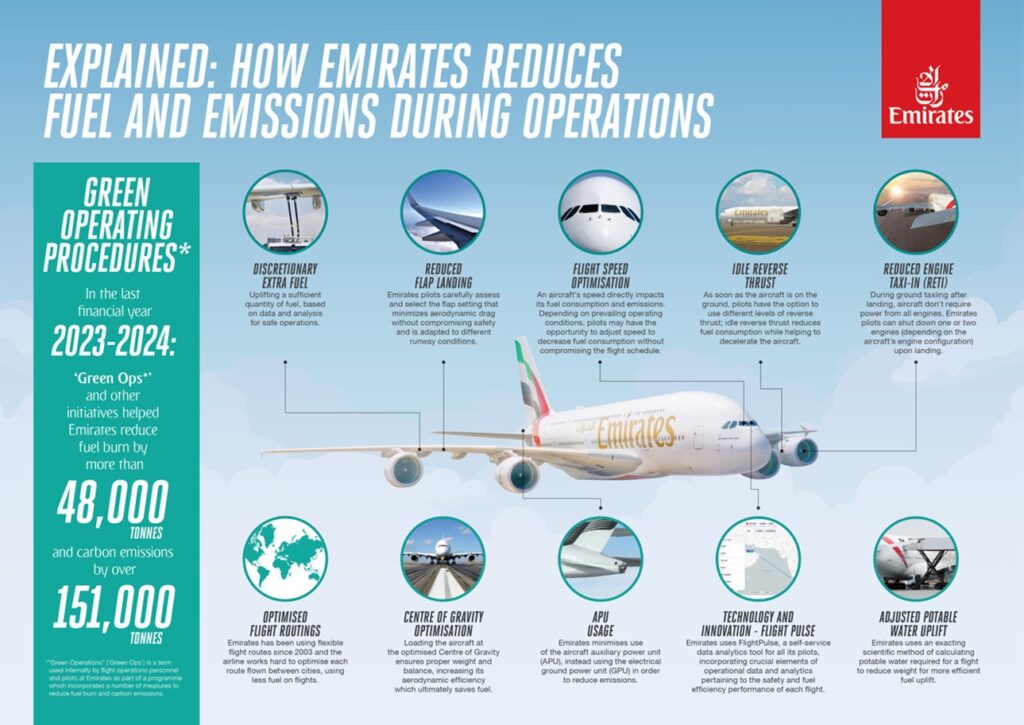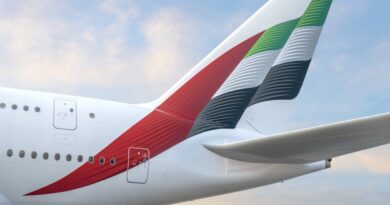Emirates Pilots Cut Fuel and Emissions with Innovative “Green Ops”
Emirates is making significant strides towards sustainable aviation through its “Green Operating Procedures” (Green Ops), introduced in 2016. This initiative, which encompasses a wide range of measures to reduce fuel consumption and emissions, has been crucial in the airline’s efforts to fly smarter and greener.
Under the leadership of an internal cross-functional Operations Efficiency Steering Group, Emirates is committed to minimising unnecessary fuel burn and emissions while maintaining its high safety standards. In the last financial year, 2023-2024, Green Ops and other operational initiatives led to a reduction of over 48,000 tonnes of fuel burn and more than 151,000 tonnes of carbon emissions.
Captain Hassan Al Hammadi, Emirates’ Divisional Senior Vice President Flight Operations, expressed pride in the collective efforts of the Flight Operations team and the significant contributions of the pilots in reducing fuel consumption and emissions.
He highlighted that this achievement is a testament to the discipline, commitment, and dedication to sustainable aviation practices within the cockpit, all while upholding the highest safety standards.
Al Hammadi noted that Emirates has equipped its pilot community with the latest tools and applications to monitor and review flight performance, enhancing their awareness of how flying techniques impact fuel consumption and emissions.
Furthermore, Captain Al Hammadi emphasised the airline’s ongoing commitment to investing in cutting-edge technologies and accelerating solutions that deliver long-term environmental benefits.
Emirates has implemented several key operational measures to reduce fuel burn and emissions. One such measure is the discretionary extra fuel initiative, which encourages captains to uplift extra fuel based on informed judgement and legitimate operational needs, supported by pertinent data and analysis. This has significantly reduced the uplift of discretionary extra fuel.
Another measure is flight speed optimisation, where pilots adjust flight speeds based on thorough calculations to minimise total operating costs and reduce fuel consumption without compromising flight schedules. Reduced flap landing is also employed, with pilots selecting flap settings that minimise aerodynamic drag, reducing fuel consumption while ensuring safety.
Idle reverse thrust is used on landing, allowing pilots to decelerate the aircraft using idle reverse thrust, which reduces fuel consumption based on runway conditions. Additionally, reduced engine taxi-in (RETI) has been implemented, where pilots shut down one or two engines during ground taxiing after landing. This practice has increased nearly sevenfold since its introduction.
Optimised flight routings are another critical measure. Emirates collaborates with air traffic control and industry bodies to optimise flight routes, reducing fuel use and emissions while saving time for passengers. The use of the FlightPulse tool, developed with GE Digital Aviation Services, enables pilots to monitor and review flight performance data, enhancing safety and fuel efficiency.
Centre of gravity optimisation is also practised, with aircraft loaded to the optimised Centre of Gravity to improve aerodynamic efficiency and reduce fuel burn. Minimising the use of the aircraft auxiliary power unit (APU) and using electrical ground power units instead has reduced APU use by more than 30%.
Lastly, Emirates calculates the exact amount of potable water required for each flight, reducing weight and ensuring efficient fuel use. These initiatives reflect Emirates’ commitment to sustainable aviation and industry innovation. By adopting these measures, the airline continues to enhance its operational efficiency and environmental performance.



